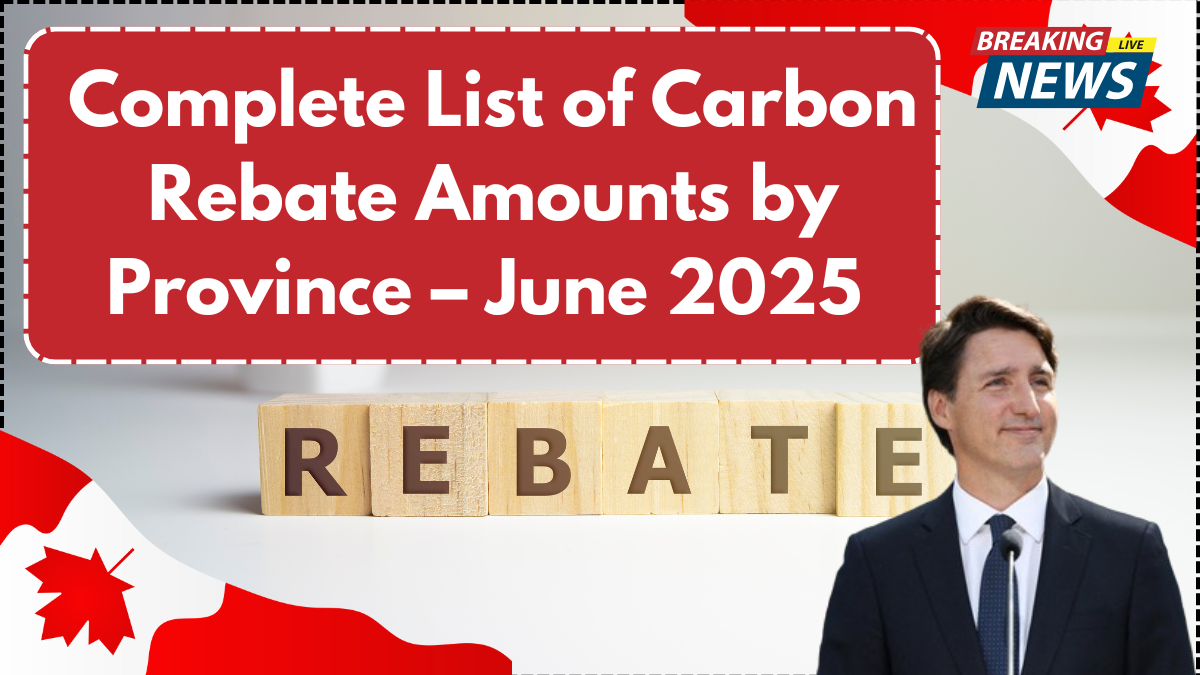As of May 2025, the federal Climate Action Incentive Payment (CAIP) continues to provide quarterly tax-free rebates to Canadians. This initiative aims to offset the financial impact of the federal carbon pricing system. Canadians living in provinces where the federal carbon backstop applies receive these payments directly, with no application necessary. The rebate is designed to make the carbon tax revenue-neutral for most households, particularly those with low or middle incomes.

Provinces Eligible for CAIP in 2025
To receive CAIP, individuals must reside in one of the following provinces as of May 2025:
- Alberta
- Saskatchewan
- Manitoba
- Ontario
- Newfoundland and Labrador
- Nova Scotia
- Prince Edward Island
- New Brunswick
Residents must file their tax return to be eligible, even if they have no income to report. This ensures the Canada Revenue Agency (CRA) can assess and process their payments.
June 2025 Carbon Rebate Amounts by Province
For the June 2025 quarter, CAIP payments have been increased slightly in most provinces to reflect annual inflation adjustments based on 2024 data. The following table outlines the payment amounts by province:
| Province | Individual | Spouse/Common-Law Partner | Per Child (Under 19) | Family of Four |
|---|---|---|---|---|
| Alberta | $225 | $112.50 | $56.25 | $450 |
| Saskatchewan | $188 | $94 | $47 | $376 |
| Manitoba | $150 | $75 | $37.50 | $300 |
| Ontario | $140 | $70 | $35 | $280 |
| Newfoundland & Labrador | $164 | $82 | $41 | $328 |
| Nova Scotia | $156 | $78 | $39 | $312 |
| Prince Edward Island | $140 | $70 | $35 | $280 |
| New Brunswick | $148 | $74 | $37 | $296 |
These amounts are disbursed quarterly in April, July, October, and January.
How the CAIP Payment Is Delivered
Payments are distributed automatically by the CRA either via direct deposit or mailed cheque. Taxpayers do not need to apply, but filing an annual income tax return is mandatory to receive the rebate. Rural residents in the above provinces may qualify for a 10% rural supplement, acknowledging the greater fuel costs and limited low-carbon transit options in remote areas.
Purpose of the Carbon Rebate Program
Canada’s carbon pricing strategy is a critical component of its climate action framework. By assigning a cost to carbon emissions, it encourages individuals and businesses to reduce their environmental footprint. The CAIP rebate is essential to maintaining public support by ensuring that the majority of households, especially those with modest incomes, receive more in rebates than they pay in carbon tax.
This approach also maintains the policy’s effectiveness while reducing financial strain, especially during periods of high inflation or energy price volatility.
New Developments as of 2025
- Higher Rebate Payments: Reflecting inflationary changes from 2024, most provincial rebates have increased in June 2025.
- Enhanced Fraud Prevention: The CRA has rolled out improved verification protocols to safeguard the system against ineligible claims.
- Rural Supplement Reassessment: The federal government is reviewing whether to expand the rural 10% top-up or create variable rates based on regional fuel costs.
- Potential Additions to Climate Incentives: The government is exploring integration of the CAIP with home energy retrofitting programs and low-emission transit incentives in future updates.
Looking Ahead: The Future of CAIP
With the federal carbon price set to rise annually through 2030 under Canada’s climate commitments, CAIP will remain a key tool for public affordability. As emission targets become more ambitious, the federal government may adapt the rebate program further to include targeted supports or new eligibility tiers.
Conclusion
The CAIP continues to serve as a vital financial support mechanism, ensuring that the carbon tax system in Canada is fair and functional. As of June 2025, Canadians in applicable provinces can expect slightly increased payments, with possible future enhancements under review. Staying informed through CRA updates ensures you receive your entitled payments without disruption.
FAQs About CAIP in 2025
Who qualifies for the Climate Action Incentive Payment?
Anyone residing in a province where the federal carbon pricing applies and who files an income tax return is eligible.
How often are CAIP payments made?
Payments are issued quarterly: April, July, October, and January.
Is there a need to apply for CAIP?
No application is required. Filing your annual tax return is sufficient.
Do rural residents get more?
Yes, rural residents receive a 10% supplement due to higher fuel needs and fewer alternatives.
What if I didn’t get my payment?
Check with the CRA to ensure your tax return was filed and that your information is up-to-date.
Will the rebate increase in the future?
Yes, amounts are indexed to inflation and likely to increase as carbon pricing rises through 2030.
Are payments taxable?
No, CAIP payments are non-taxable.
Can new residents qualify?
Yes, if they live in an eligible province and file taxes for the year.
How does CAIP support climate goals?
It reduces net costs to households while keeping the incentive to cut emissions intact.
Is the CAIP changing in 2026?
Possible changes are under review, especially regarding rural supplements and climate support program integration.
Click here to know more.

